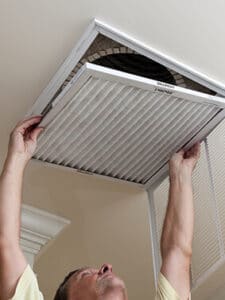Indoor Air Quality Assessments In St. Louis

With the right types of ventilation in your St. Louis area home, you and your family can breathe fresh, clean, and healthy air. At Greenmark Home Performance, we have a team of professionals who will be able to assist you with determining what types of ventilating systems will be necessary, whether you need a whole-home system or exhaust fans in the kitchen or bathroom, we can help.
Contact Us For Professional Indoor Air Quality Assessments
How Poor Air Quality Affects Your Home
Poor indoor air quality can have a number of effects on you, your family, and any pets you may have. While the effects may not seem obvious at first, they can quickly escalate and become dangerous if your home is not properly ventilated. Many of the symptoms of poor indoor air quality are depended on what air pollutant is present in your home, and can easily be mistaken for symptoms of other illnesses such as allergies, stress, colds, and influenza. The most common symptoms you will see are:
Signs and Symptoms:
- Coughing
- Watery eyes
- Dizziness
- Congestion
- Sneezing
- Fatigue
- Headaches
Common Air Pollutants
This includes mold, bacteria, pollen, pet dander, and viruses. Problems here can lead to asthma attacks, allergic reactions, and other medical problems. To help alleviate symptoms, bedding can be washed, animals can be kept out of areas where people spend the most time or sleep, and thorough cleaning of all surfaces should be done to prevent dangerous mold growth.
This contains over 200 poisons, including formaldehyde and carbon monoxide. It also contains 60 different chemicals which are linked to cancer. In the U.S. every year, this problem is known to cause around 3,000 deaths in non-smokers and nearly 50,000 heart disease deaths. It proves to be especially problematic for the young, including children and infants who often will suffer from recurring pneumonia, respiratory tract infections, and ear infections.
This comes from fuel burning stoves, furnaces, fireplaces, and water heaters. The most dangerous type of combustion pollutant is carbon monoxide since it can’t be seen, tasted, smelled, or really even noticed at all until it starts to cause serious health problems, including: fatigue, headaches, confusion, nausea, and dizziness. In extreme cases with very high levels of carbon monoxide, some individuals may lose their life.
This is a naturally-occurring radioactive gas which is able to get into a home through cracks and crevices in the foundation. It is the leading cause of lung cancer in non-smoking individuals in the U.S. To reduce the levels of Radon in a home, testing and remediation work will need to be done.
This is a non-flammable mineral which can produce very tiny fibers. When breathed in over a long period of time, the fibers can actually scar lung tissue. Many asbestos products in a home include flooring materials, insulation, and heating equipment. An air-tight seal of the home’s building envelope is needed and removal of dangerous materials will be required for this pollutant.
This is a common chemical that is found in adhesive or bonding materials, such as in carpets, upholstery, and particle board. When it is released into the air, it can cause coughing, eye and throat irritation, and even cancer. To reduce your risk of these problems, minimize your use of products containing the chemical.
How We Reduce Indoor Air Pollution
There are a variety of ways in which our team can help you reduce the indoor air pollutants in your home. Each of these methods are designed to combat the sources of pollutants in your home and can help increase the overall air quality in your home.
Source Control
Our team can remove any obvious causes of poor indoor air quality in your home. This can include contaminated carpets, walls, or even replacing ventilation solutions.
Ensure Proper Ventilation
Proper ventilation in your home can be the key to increasing the air quality in your home. Replacing polluted and contaminated air with fresh air is simple with a viable home ventilation system.
Ensure Proper Air Filtration/Cleaning
Replacing old air filters is a key factor in keeping the air in your home fresh. An old and worn-out air filter can contaminate the air in your home that is being circulated through your HVAC system.
Improve Your Home's Air Quality With Professional Indoor Air Quality Assessments in St. Louis
Your home’s air quality should be of the utmost importance. Our team at Greenmark Home Performance can perform a indoor air quality assessment on your home to help get you on track with better air quality. Contact us online or by calling us at 314-845-9144 to schedule an appointment.